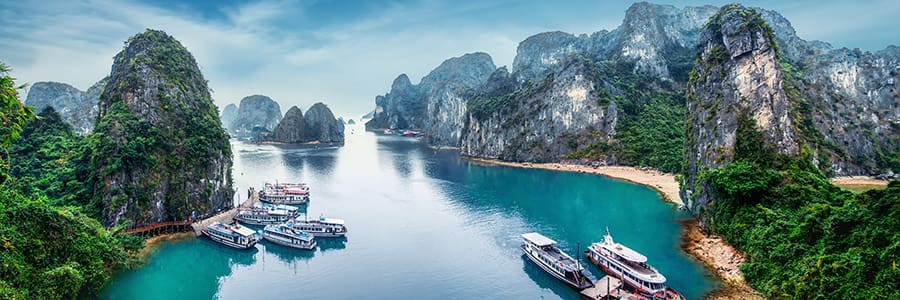
About The Red River & Halong Bay
The name Ha Long means “descending dragon.”
Flowing southeastward from Yunnan in southwest China through northern Vietnam to the Gulf of Tonkin, the Red River runs for nearly 714 miles before spreading out to form the Red River Delta. The river is notorious for its violent floods, so an ingenious network of dikes and levees was installed to protect the delta’s vast rice fields.
For the adventurer looking to explore places few others have visited, Northern Vietnam offers rare and marvelous wonders, well worth the journey. Remote mountain villages and tribal areas contrast with the modern whirl of downtown Hanoi, while the busy hum of floating markets balance the silent splendors of tranquil rice paddies and Halong Bay, a UNESCO World Heritage Site boasting a fantastical array of limestone karsts and isles set amidst sparkling tropical waters.
Given the increasing popularity of Halong Bay, many of the major river cruise lines offer cruises featuring the bay and the Red River, with most chartering specially designed paddle steamers, such as the RV Angkor Pandaw. With their shallow draft, the steamers can navigate the uncharted waters, with their shifting sandbars, and still travel upstream or downstream in the dry season, when waters are at their lowest.
Red River & Halong Bay Stats
Length: 714 miles
Depth: Up to 33 feet
Source: Hengduan Mountains, Yunnan, China
Mouth: South China Sea at Halong Bay near Hanoi, Vietnam
Locks: 0
Countries: China | Vietnam
Learn More About the Red River and Halong Bay
The Red River and Halong Bay are two of the most iconic natural wonders in Northern Vietnam, each offering a unique and captivating experience for travelers. These two distinct geographical features not only showcase the incredible diversity of Vietnam’s landscapes but also hold cultural, historical, and ecological significance. Let’s embark on a journey to explore the beauty and significance of the Red River and Halong Bay.
The Red River
The Red River, known as the “Hong Ha” in Vietnamese, is one of the major rivers of Southeast Asia. It flows from its source in Yunnan, China, through Northern Vietnam before emptying into the Gulf of Tonkin. This mighty river plays a pivotal role in the lives of millions of people in the region, shaping the landscape, culture, and economy of Northern Vietnam.
Geography and Landscape
The Red River Delta is a vast alluvial plain created by millennia of sediment deposition from the river. It is a lush, fertile region known for its rice paddies and wetlands. The river’s yearly flood cycle replenishes the soil, making it one of the most agriculturally productive areas in Vietnam. The Red River’s sinuous path through this delta has created a network of distributaries and waterways, crisscrossing the landscape and providing essential irrigation for the region’s agriculture.
Cultural Significance
The Red River has been a cradle of civilization for thousands of years. It is home to several ethnic groups, including the Kinh people, who make up the majority of Vietnam’s population, and various minority groups like the Tay and Nung. The river has witnessed the rise and fall of ancient kingdoms and dynasties, and its banks are dotted with historical sites and relics, such as the ancient city of Co Loa.
Economic Hub
The river serves as a vital transportation route, facilitating trade between Hanoi, the capital of Vietnam, and the neighboring provinces. It also connects Vietnam to China via the border crossing at Lao Cai, playing a crucial role in international trade.
Challenges and Preservation
While the Red River brings immense benefits, it also poses challenges, particularly during the monsoon season when flooding can displace communities and damage crops. Additionally, pollution and industrial development have led to water quality issues. Efforts are being made to balance economic development with environmental preservation to ensure the river’s long-term sustainability.
Halong Bay
Halong Bay, located in Quang Ninh Province, is often referred to as the “Bay of the Descending Dragon.” It is a UNESCO World Heritage site and one of the most iconic natural wonders in Vietnam. Halong Bay’s breathtaking beauty and mystical charm have made it a must-visit destination for travelers from around the world.
Geological Marvel
What sets Halong Bay apart is its unique geological formations. Thousands of limestone karsts and islets rise dramatically from the emerald waters of the Gulf of Tonkin, creating a surreal and ethereal seascape. These karsts have been shaped over millions of years by the erosive forces of wind and water, resulting in caves, grottoes, and hidden lagoons.
Island Exploration
Halong Bay offers numerous opportunities for exploration. Tourists can take boat trips that navigate through the maze of karsts, discovering hidden coves and pristine beaches. Many of these islands have their own unique characteristics and legends associated with them. Ti Top Island, for example, is known for its panoramic viewpoint at the summit, while Sung Sot Cave (Surprise Cave) is a spectacular cavern adorned with intricate stalactites and stalagmites.
Marine Biodiversity
Beyond its stunning topography, Halong Bay is home to a diverse range of marine life, including fish, crustaceans, and even rare species like the Cat Ba langur. The bay’s waters are dotted with fishing villages, where communities rely on the rich marine resources for their livelihoods.
Environmental Conservation
Halong Bay’s popularity as a tourist destination has led to concerns about environmental degradation. Efforts are being made to mitigate these impacts through sustainable tourism practices, waste management, and stricter regulations on cruise operations. Preservation of this natural wonder is essential to ensure that future generations can also marvel at its beauty.
